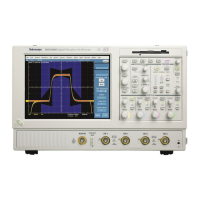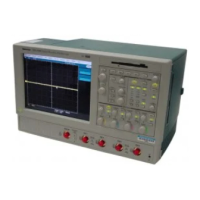TDS5000B Online Programmer Guide
-- 5 3 --
Data Formats
Acquired waveform data uses eight or more bits to represent each data
point. The number of bits used depends on the acquisition mode speci-
fied when you acquired the data. Data acquired in SAMple or ENVe-
lope mode uses eight bits per waveform data point. Data acquired in
AVERage mode uses up to 14 bits per point.
The instrument can transfer waveform data in either ASCII or binary
format. You specify the format with the DATa:ENCdg command. The
instrument uses signed, 4 byte integers and floating point values; it does
not support unsigned floating point values.
ASCII data is represented by signed integer or floating point values.
An example ASCII waveform data string may look like this:
CURVE<space>-110,-109,-110,-110,-109,-107,
-109,-107,-106,-105,-103,-100,-97,-90,-84,-80
Use ASCII to obtain more readable and easier to format output than
binary. However, ASCII may require more bytes to send the same val-
ues than it does with binary. This may reduce transmission speeds.
Binary data can be represented by signed integer or floating point val-
ues. The range of the values depends on the byte width specified. When
the byte width is one, signed integer data ranges from --128 to 127, and
positive integer values range from 0 to 255. When the byte width is
two, the values range from --32768 to 32767. When a MATH (or REF
that came with a MATH) is used, 32 bit floating point values are used
that are four bytes in width.
The defined binary formats specify the order in which the bytes are
transferred. The following are the four binary formats:
H RIBinary specifies signed integer data --point representation with
the most significant byte transferred first.
H SRIBinary is the same as RIBinary except that the byte order is
swapped, meaning that the least significant byte is transferred first.
This format is useful when transferring data to PCs.
H RFBinary specifies floating point data --point representation with
the most significant byte transferred first.
H SRFBinary is the same as RFBinary except that the byte order is
swapped, meaning that the least significant byte is transferred first.
This format is useful when transferring data to PCs.
Waveform Data and Record Lengths
You can transfer multiple points for each waveform record. You can
transfer a portion of the waveform or you can transfer the entire record.
You can use the DATa:STARt and DATa:STOP commands to specify
the first and last data points of the waveform record.
When transferring data into the instrument, you must first specify the
record length of the destination waveform record. You do this with the
WFMInopre:NR_Pt command. Next, specify the first data point within
the waveform record. For example, when you set DATa:STARt to 1,
data points will be stored starting with the first point in the record. The
instrument will ignore the value set by DATa:STOP when reading in
data. It will stop reading data when there is no more data to read or
when it has reached the specified record length.

